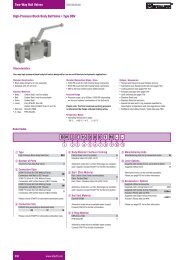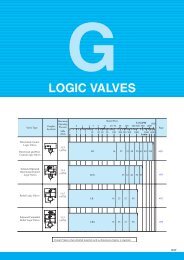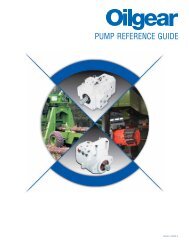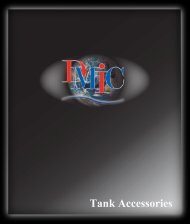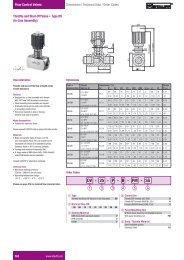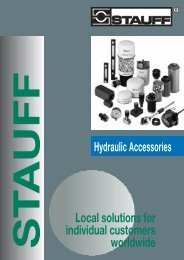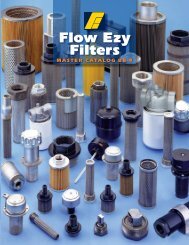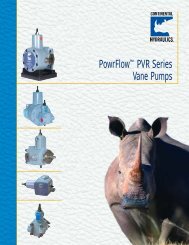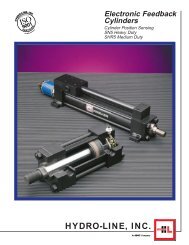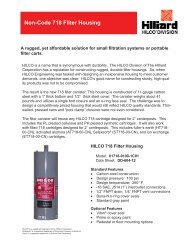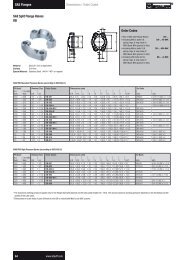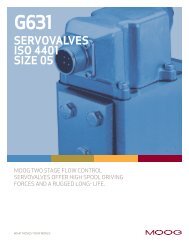Electrohydraulic Valves - Moog Inc
Electrohydraulic Valves - Moog Inc
Electrohydraulic Valves - Moog Inc
- No tags were found...
Create successful ePaper yourself
Turn your PDF publications into a flip-book with our unique Google optimized e-Paper software.
PRACTICAL CONSIDERATIONS WHEN LAYING OUTELECTROHYDRAULIC CONTROL SYSTEMS1.Power UnitsPumps:Constant supply pressure is preferred with minimumvariation. Use accumulators with variable displacementpressure compensated pumps. Fixed displacement pump:constant pressure with use of accumulator is an option.– If more than one critical system is fed from one pump,isolate each system with check valves and accumulators(avoids cross-talk).– Reservoir breather: 3 to 5 micron air filter preferredwith capacity appropriate to fluid displacement.– Temperature and pressure should be closely controlledif good long term control accuracy is critical.– Fluid flowing over a relief valve represents wasted energy.2.Piping and FittingsDo not use pipe dope. (It contains fine, hard to filter, particulate.)Use TFE tape when necessary. Do not use pipe or pipe fittings.– Use only correct tube cutting tools, no hacksaw.Deburr if necessary.– Cold bending preferred.– Descale after hot bending and welding.Rotating joints can generate contamination.– Flexible lines: if unavoidable use teflon, nylon orthermoplastic lined hoses rather than rubber (neoprene)which eventually shed particles. Place flex lines before filter,not after.– Use O-ring fittings rather than tapered pipe type. If pipefittings cannot be avoided, use Teflon tape.3. FiltrationThe <strong>Moog</strong> filtration philosophy is summarized as follows:– Use a 10 to 15 micron absolute non-bypass high pressurefilter just before the Servo or Proportional Valve.– Use a 3 micron low pressure filter in the return line,if possible.– Use a 3 to 5 micron low pressure filter in an off-linefiltration loop.– Recirculate oil in reservoir more than 5 times per hour.This is justified on the bias that:(i) The Servo or Proportional Valve can accept the oddparticle up to 25 microns.(ii) It is neither practical nor economical to try to cleanthe oil with a small, relatively expensive, high pressureelement.The cheaper, low pressure element is manytimes larger and has the potential to filter continuallyand under more ideal conditions. (Steady flow andlower velocities increase filtration efficiency.)– In the case where large changes of oil volume in thereservoir occur, as with a single ended hydraulic cylinder,it is suggested that a 3 micron low pressure element beused as an air breather.– Always use dirt alarms/pressure switches to enablechanging of elements at correct intervals.– Use cheaper low-pressure flushing elements to flush thesystem on start-up – remember that new oil is “dirty oil,”having picked up contaminant in transit and packaging.– The tank volume should be flushed through the filter atleast 50 times, changing the element when indicated by thepressure switch (contaminate alarm), or until the systemhas operated 6 to 8 hours without the need for a flushingelement change.4. Servo and Proportional Valve –Characteristics of Major Importance:– Frequency response (time constant)– Threshold (resolution)/hysteresis4.1 Placement:– Mount as near as possible to the actuator to reducethe entrapped oil volume. Oil is compressible and canoften limit servo response.– Flexible lines between valve and actuator can berarely justified. As a rule of thumb they decreasestiffness to one-third of the volume that they contain.Additionally, they produce contamination which mustpass through the valve. Use only nylon, teflon orthermoplastic lined hose.4.2 Sizing:– Select the valve size to obtain between 1/4 and1/3 system pressure (PS) drop across the valve atmaximum velocity. If the drop across the valve is toosmall, then a flow change will not take place until thevalve is nearly closed.– Remember: to control flow the valve must droppressure across itself. Too large a valve is a waste, orworse than that, it lowers system resolution.20



